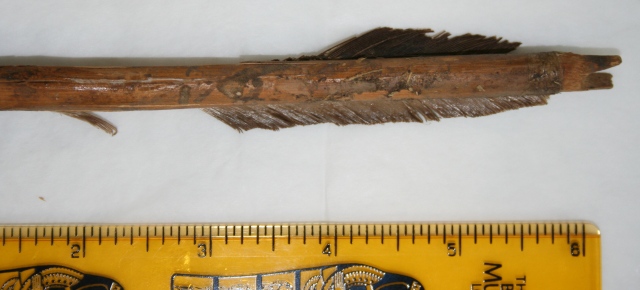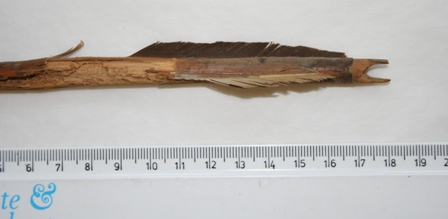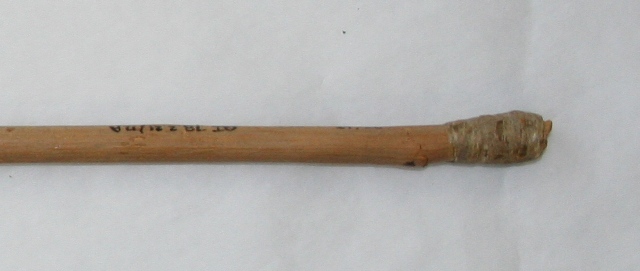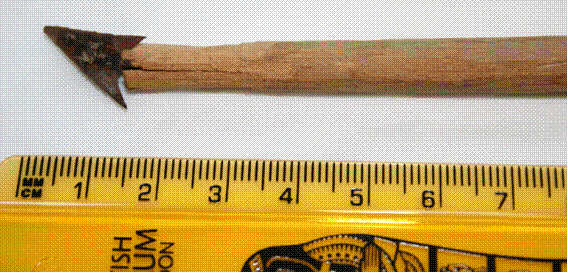|
|
| Roman arrows
by Caballo (Paul Brown). 2007.
1. Introduction
While many arrow heads have survived, very
few examples of fletching and the actual arrow shafts remain.
Two major finds are from Dura Europos and the Roman Meroitic
remains (although there are references in James to arrow finds
from Nahal Tse'elim and Masada) . The objective here is to
compare these fletchings and arrow shafts; and to draw out
some interim conclusions regarding how far these arrows can
shed light on others. Having been fortunate enough to examine
the Roman Meroitic arrows at first hand, I would like to thank
Dr Neal Spencer of the Egyptian section for his invaluable
help in allowing the huge privilege of access.
2. Dura Europos background
Dura Europos was a city on the Middle Euphrates
in present day Syria. It was founded by the Macedonians, ruled
by the Parthians and annexed by the Romans. In 255/6 AD, the
Roman garrison was besieged in the city by a Sassanian army.
From this period comes an astonishing assembly of items- wooden
shields, horse armour, which, when found could be placed on
a horse, bolt quarrels, and many other items of military and
civilian equipment- including arrows. Simon James's book "Final
Report VII: The Arms and Armour and other Military Equipment"
cannot be recommended highly enough, and this article draws
on it heavily.
3. Qasr Ibrim background
Qasr Ibrim (Arabic, castle of Ibrim, with linguistic
link to Castra) is located in Lower Nubia in modern day Sudan.
Under Augustus, a Roman garrison was stationed there under
prefect Gaius Petronius who defeated a Meroitic army after
their invasion of Lower Nubia in 24 BC. Finds include quarrels
from bolt-shooters, and artillery balls; some with slogans
identifying the century and one identifying the targeted enemy
leader!
4. Comparison of
arrows
|
| |
Dura Europos |
Qasr Ibrim |
| Shaft material |
Reed, wood (tamarisk?), Reed/ wood
combination (e.g. arrow shaft of reed cane, 10 mm diameter,
into the end of which is inserted a tapered wooden footing which
forms the front part of the arrow shaft. Similar design found
at Nahal Tse'elim and Vindonissa. James, pp204/5) |
Reed (diameter 7-8mm), Wood (diameter
8mm, tapering to arrowhead).
Wooden shaft considerably more robust than reed arrows.
|
| Fletching shape
|
Parabolic |
Parabolic |
| Fletching length |
151-157mm |
113mm |
| Fletching colour |
White? |
Light brown |
| Fletching attached
with ... |
Glue |
Glue |
| Fletching Style |
"Western" style with
cock feather set at right angles to the axis of the nock and
a hen-feather at 120 degrees to either side of it. Not cork-screwed
(to make arrow spin), although natural twist in the feather
will accomplish this. |
Three feathers with "cock"
feather set at 120 degrees to nock. Not cork-screwed. |
| Binding/
whipping between fletching and nock? |
Yes ("glued fibre
(tendon?)… to prevent cane splitting": James) |
Yes. Appears similar
to Dura Europos. |
| Width of binding |
10mm width, 9mm from nock end |
4-6mm width, 8-12 mm from nock
end. |
| Self nocked (i.e.
no additional material at nock) |
Yes |
Yes |
| Nocking depth |
8-10mm |
4-9mm |
| Decoration "cresting"
on nock |
Black base, with white and red
(see picture). 2nd century arrows found at Nahal Tse'elim in
Judea also possess similar red and black cresting; parallel
red and black cresting found throughout Asia, including contemporary
Han Chinese crestings) |
Black painted nock |
| Arrow head description |
Sharpened wood; copper alloy two
bladed 29-98mm length; copper alloy three bladed 19-50mm; iron
two bladed 60-67mm; iron three-bladed 35mm-88mm |
Iron three-bladed tanged head (still
attached). Length along blade edge 19mm. Length of head (excluding
tang) 14mm. |
| Draw type |
Thumb ring |
Probable thumb ring (in comparison,
a modern parabolically fletched Hungarian arrow -traditionally
made- has a gap between fletching end and nock end of c.40mm) |
| Other comments |
|
Tapered shaft towards arrow head,
with signs of "whittling". |
| |
None of these exhibited any
signs of a whipping in front of the fletching, nor of a medieval-style
linen thread binding the fletching to the shaft in addition
to the glue.
None of the sculptural references that I have seen have indicated
the "v-shaped" medieval style fletching rather than
a parabolic fletching- though erosion (e.g. on Trajan's column)
do not make this a conclusive finding.
5. Conclusions
These arrows show a remarkable amount of overlap-
parabolically fletched, binding at the nock end, crested using
colour combinations. The material (wood/ reed) may also reflect
both local materials and manufacturing preference.
A key question is how far it is possible to
extend these arrows to other parts of the Roman Empire. Certainly,
Dura Europos and Qasr Ibrim were "outposts of Empire"
- though from a Roman perspective, no further from the centre
than Hadrian's Wall.
James notes "one of the most striking characteristics
of the Dura assemblage is the degree to which so much of it
matches finds from other Roman frontiers, not only in general
form, but often in the finest details…near-identical
to, and often indistinguishable from, discoveries made at
other Roman sites as far away as Scotland and Mauretania."
Having said that, an arrow would be very dependent on what
was available locally. Secondly, a Mediterranean draw would
involve a different design- particularly a longer distance
between fletching and nock.
In terms of reconstructing a Roman arrow, my
conclusion would therefore be that there is evidence for an
arrow that is:-
- Made of wood, reed or combined wood/ reed
- Parabolic fletching stuck on with glue
alone
- Binding or whipping between nock and fletching
- Decorated nock using black, white, or red
paint (also known as cresting - used today to identify arrows
belonging to a particular archer)
- Iron, copper alloy or sharpened wood point
- Two or three blade heads
|
6. Appendix
Qasr Ibrim arrow details
Three arrows were examined at the British Museum.
6.1. Arrow
with fletching (71841, ref Q1 80.2.2/48 1990-1-27.24)
Length: 178mm
Diameter: 8mm
Nock length: 9mm
Shaft material: Reed
Longest extant fletching: 113m (with gap)
Fletching: Parabolic, light brown colour, attached with glue
Binding: At nock, 12 mm from nock end. Tendon/ sinew/ linen thread
(?) 4mm wide.
Nock: Dark colour markings (probably paint)
Other: "Cock" feather at 120 degrees to nock. Three fletchings
arranged equally around shaft, without corkscrew effect


6.2 Arrow shaft, no
fletching (71845, ref Q178.2.21/12a 1990-1-27,28)
Length: 396mm
Diameter: 7mm
Nock length: 4mm
Shaft material: Reed
Fletching remains: Glue attachment only- longest remaining 57mm
of glue
Binding: At nock, 8 mm from nock end, Tendon/ sinew/ linen thread
(?) 5-6mm wide
Nock: No visible markings
Other: A very light arrow. Three fletchings, one in line with nock,
and the others equally spaced at 120 degrees off.


6.3 Arrow shaft with
three-bladed iron arrowhead still attached (71840 ref q1 80.1.21/61
A 1990- 1-27,23)
Length of shaft and arrow head: 187mm
Shaft length: 173mm
Shaft diameter: 8mm tapering to arrowhead (roughly cut)
Binding: No trace
Arrow head: Blade length 19mm, head length 14mm, tang length uncertain
as still in shaft. Two blades bent.

|

